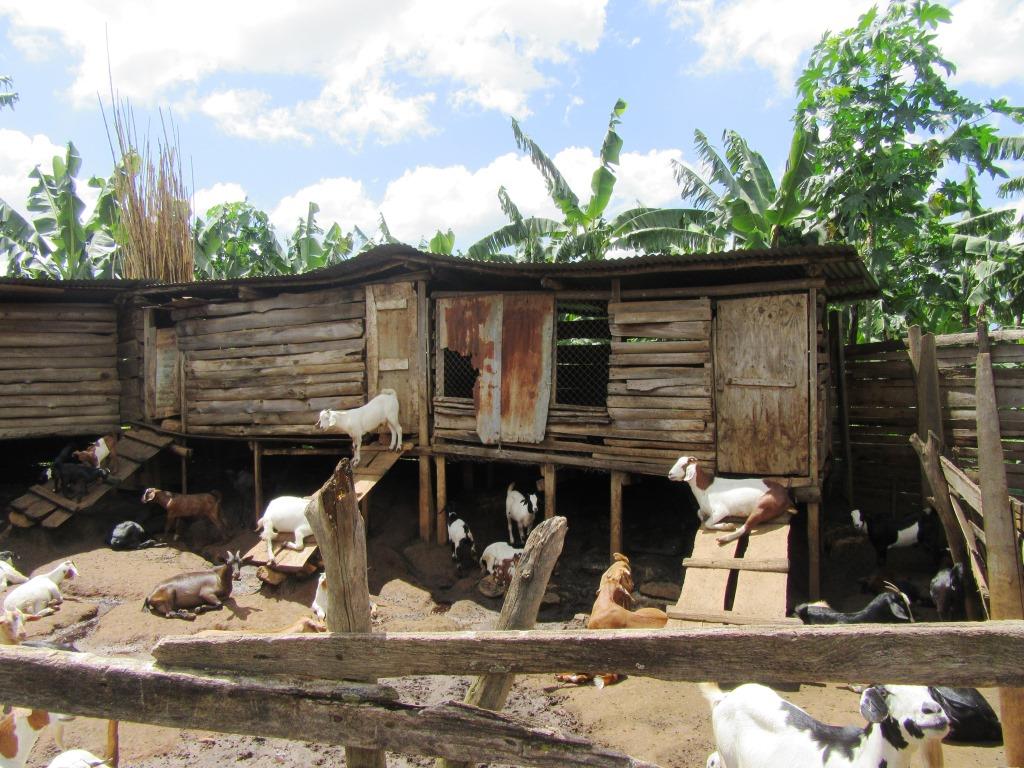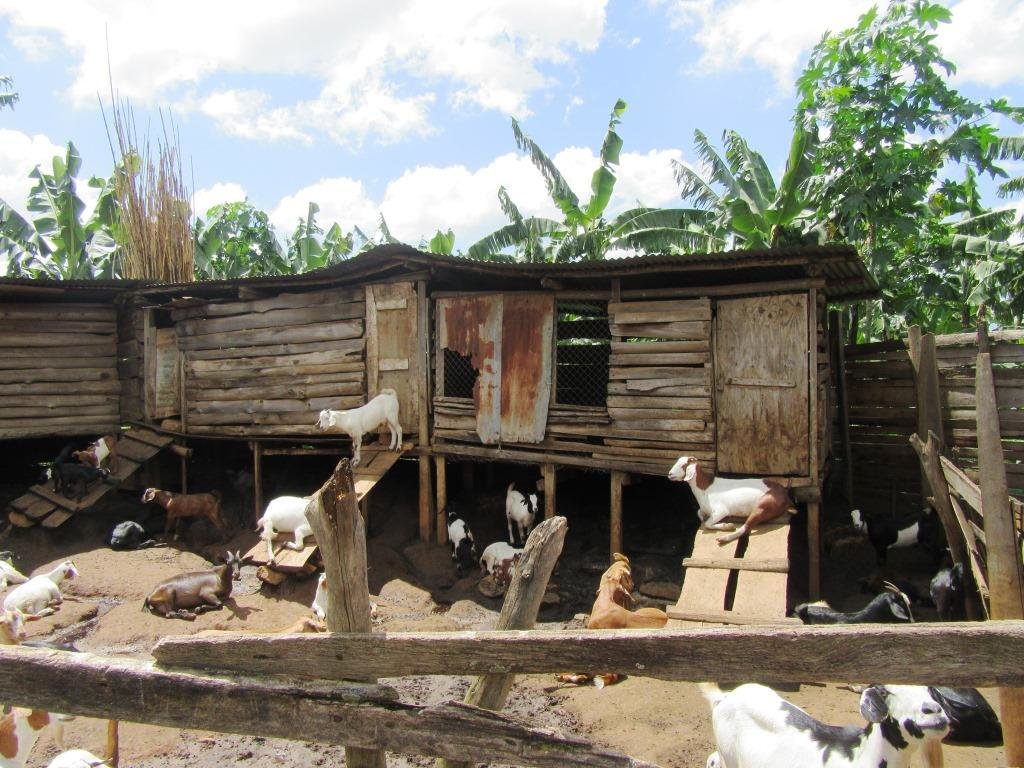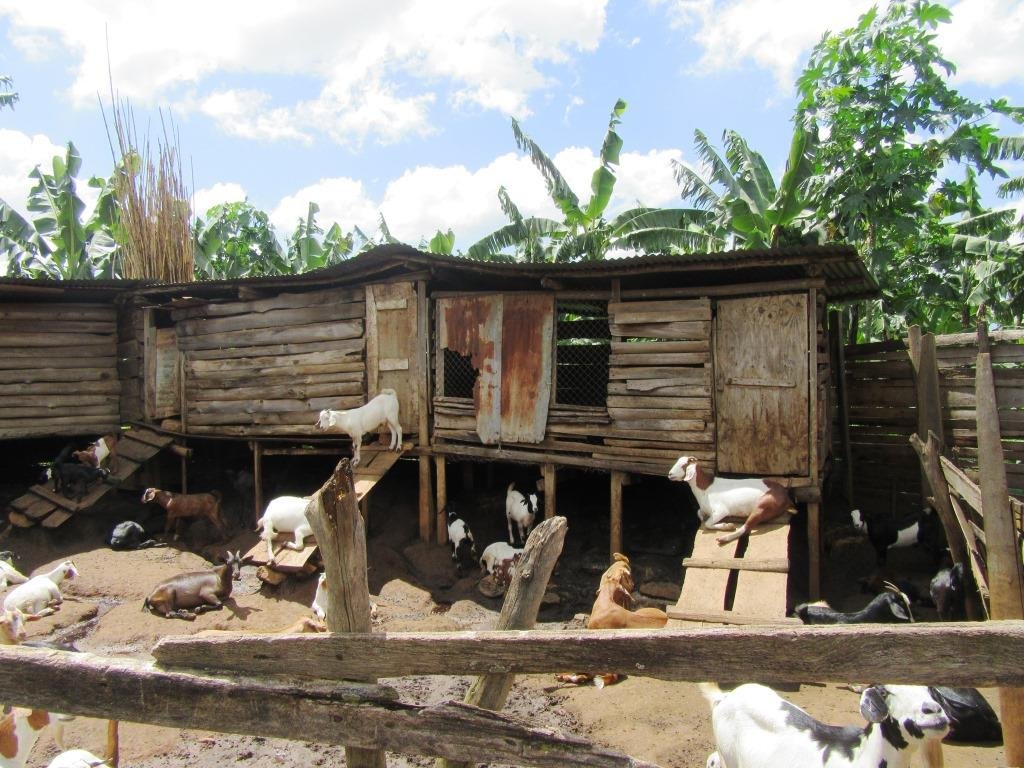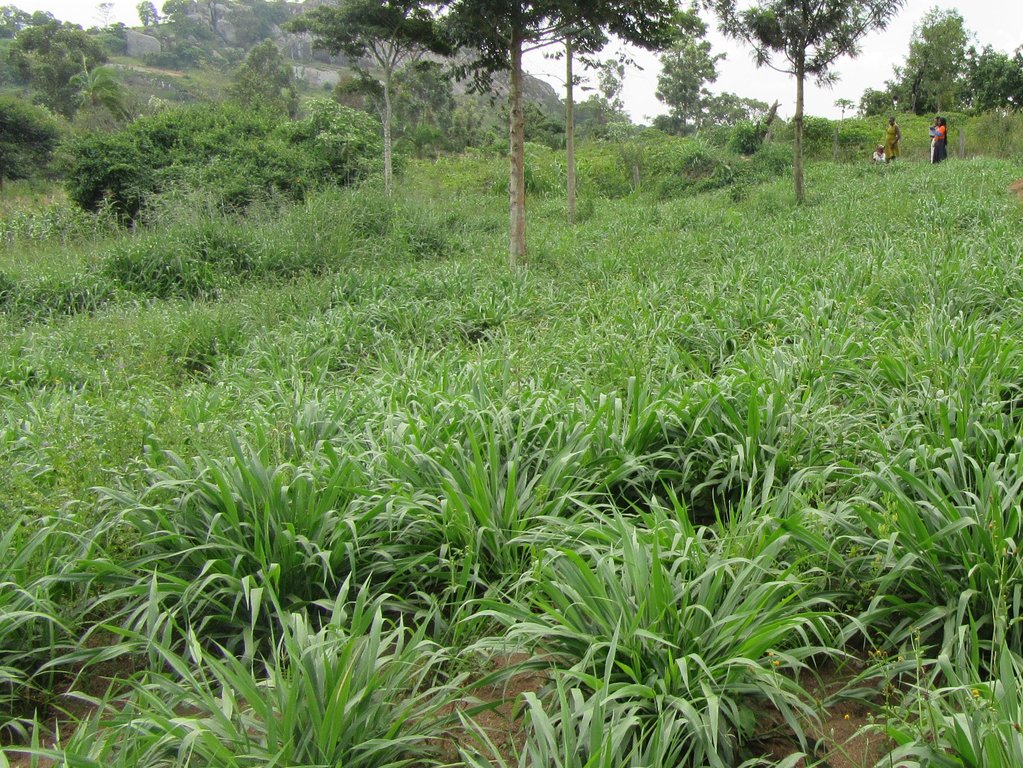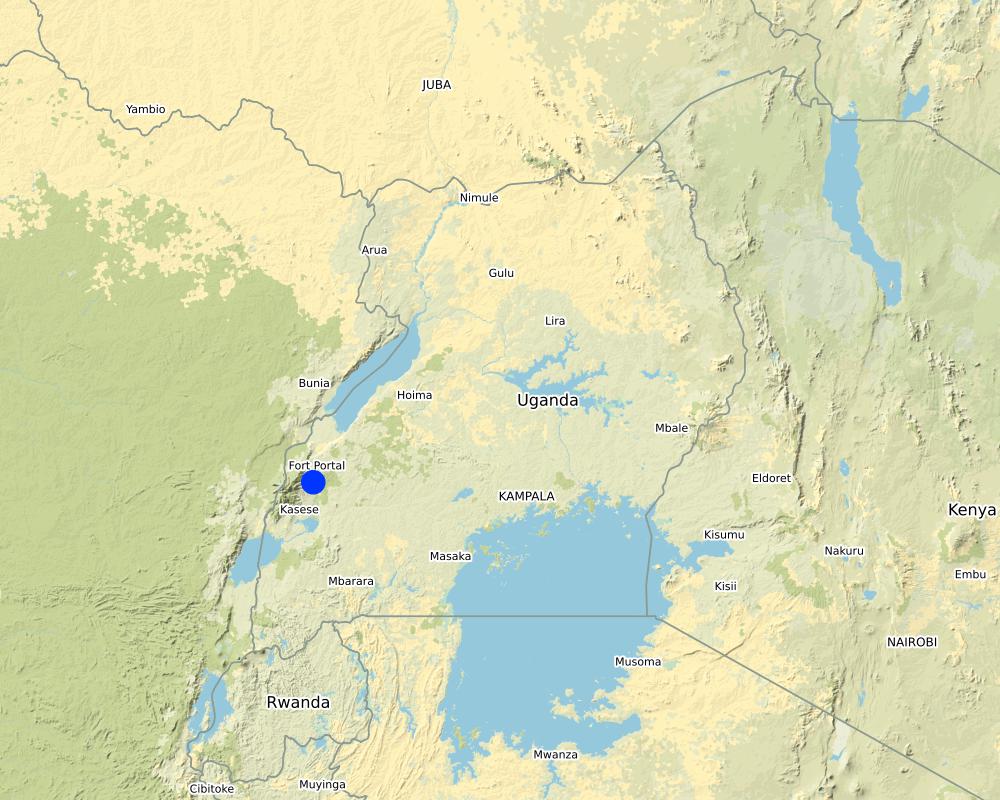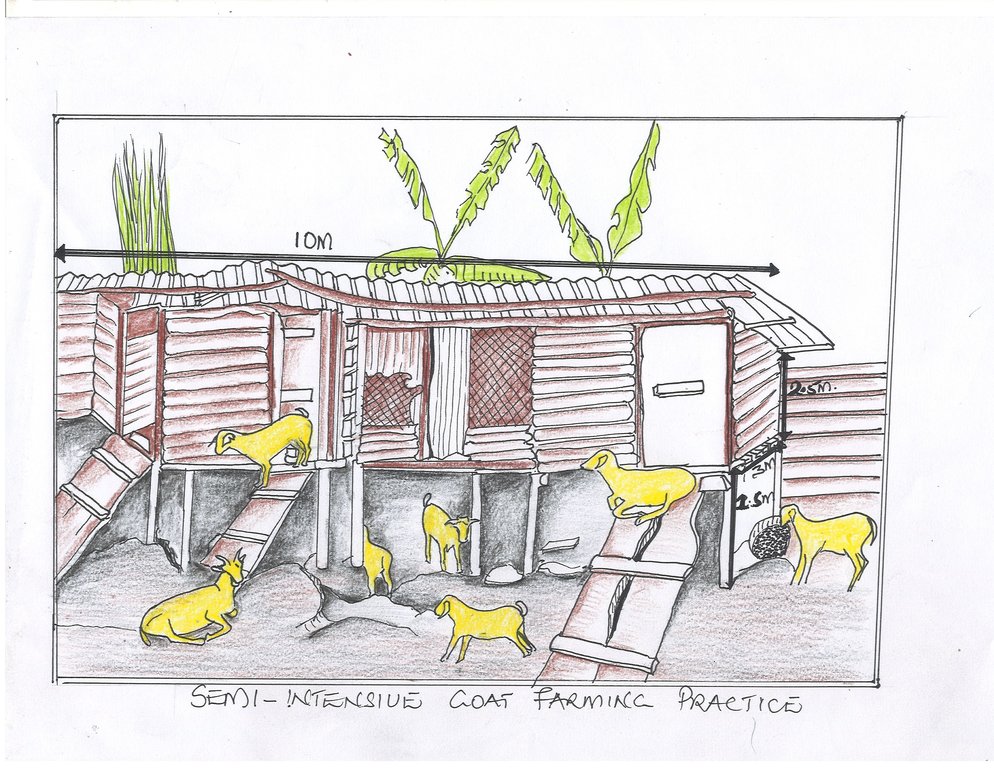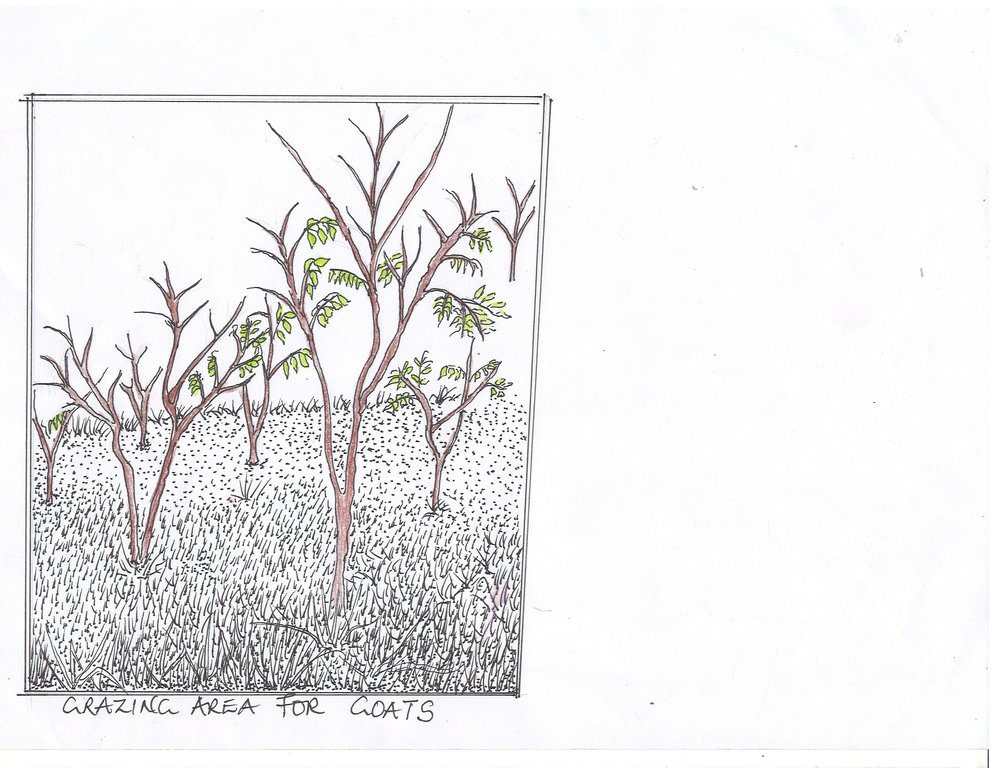Semi-Intensive Goat Farming Practice for Pasture Conservation [Uganda]
- Creation:
- Update:
- Compiler: PRISCILLA VIVIAN KYOSABA
- Editor: Kamugisha Rick Nelson
- Reviewers: Nicole Harari, Udo Höggel
Okulisa embuzi
technologies_3363 - Uganda
View sections
Expand all Collapse all1. General information
1.2 Contact details of resource persons and institutions involved in the assessment and documentation of the Technology
Key resource person(s)
land user:
Tusiime Edith
Kabarole District farmers association
Kabarole District Farmer Association
Uganda
Name of project which facilitated the documentation/ evaluation of the Technology (if relevant)
Sustainable Land Management Practices of South Africa (SLM South Africa)Name of the institution(s) which facilitated the documentation/ evaluation of the Technology (if relevant)
National Agricultural Research Organisation (NARO) - Uganda1.3 Conditions regarding the use of data documented through WOCAT
When were the data compiled (in the field)?
17/11/2017
The compiler and key resource person(s) accept the conditions regarding the use of data documented through WOCAT:
Yes
1.4 Declaration on sustainability of the described Technology
Is the Technology described here problematic with regard to land degradation, so that it cannot be declared a sustainable land management technology?
No
2. Description of the SLM Technology
2.1 Short description of the Technology
Definition of the Technology:
Goats are stall fed during dry season and open-grazed during rain season. In a semi-intensive system, animals are kept under confinement in which they are stall–fed for some period of time (weeks to months, especially during the dry seasons) followed by another period of open grazing during the rainy seasons.
2.2 Detailed description of the Technology
Description:
The semi-intensive goat rearing practice is a compromise between extensive and intensive grazing systems limited by shortage of pasture during dry seasons with high chances of spreading diseases requiring for stall feeding goats in an semi-intensive system. The goats are kept under confinement for some period of time (weeks to months, especially during the dry seasons). During dry season, the animals are fed on maize bran; iodized salt; peelings from banana, cassava, and sweet potatoes; and improved grasses (Napier) and forages planted at the boundaries of the banana plantation, which are harvested during the period of need.
The farmer has got 2 ha of banana plantation. She grows a fodder hybrid called Napier (pennisetum perpureum) around the plantation to be used as fodder for the goats during dry season. Napier grass is a perennial grass fodder commonly called elephant Grass due to its tallness and vigorous vegetative growth. She got the Napier root cuttings from the neighbor practicing the same technology. This is grown around the banana plantation, at a spacing of 60×60cm. It produces more tillers with soft and juicy stem, free from pest and diseases and non-lodging. It can be cultivated throughout the year. Napier grasses contain 6-8% protein. Its optimum cutting interval is about 6 to 8 weeks at grass range of 60 to 90 cm, if sufficient only the tops can be cut and fed. The grass is cut into 5 to 10 cm to reduce loses.
The extensive system is practiced during rainy season where the farmer grows a mixture of fodder species including Sesbania and Napier grass grown on land size of 0.5 ha. Sesbania is a fast-growing tree with regular and rounded leaves. The flowers are white and red in color according to its species but the ones at the farm are yellow. The leaves of Sesbania trees are highly palatable and mostly liked by goats. The protein content in this is about 25%. 1kg of seed was planted at a spacing of 100 cm x 100 cm. In this field Napier grass is planted in rows at a spacing of 60×60cm. The seeds for Sesbania were supplied to the farmer by the Kabarole District Production Office.
Farmers in Kabarole District use the Semi-intensive system for rearing both local and improved breeds of goats. As dry spells are increasingly becoming common, this technology helps farmers to go through the dry season with enough feed for the goats. Farmers prefer rearing goats because they don’t have complicated feeding and medical requirements. As the human population grows and land fragmentation increases, farmers in this area are now moving towards intensive feedings systems.
Throughout seasons of abundant forage, farmers harvest the forage together with grasses and make hay to feed the goats during the dry season when pastures are scarce. The cost of harvesting the hay is comparable to the cost of paying a herdsman in open grazing systems. Besides, the establishment of the shelter for goats is not cumbersome compared to those of other animals. The constructed structure occupies an area of about 12 ×12 meters squared with length of 10 meters and width is 3 meters. It is lifted ground to floor 1.5 meters and floor to roof by 2.5 meters. Further partitioned in 4 units and each unit measurement is 3 meters with a slope angle of 20 degrees. The Capacity of each unit is 18,17,17 and 18 goats respectively.
The shelter for the goats is made from relatively cheap materials that are readily available to the farmers. The farmer rears 70 goats on 1-acre piece of land using this technology. By planting improved forages in the grazing areas, the farmer receives increased amount of forage harvested as well as the quality of grass available to the goats during the open grazing periods and income after sale.One challenge of this technology is the dependence on family labor that is not always sufficient for all the tasks involved in the technology both at establishment and maintenance in addition to complications with of rural-urban migration of youth, thereby leaving the workload to the elderly.
2.3 Photos of the Technology
2.4 Videos of the Technology
Comments, short description:
A video Showing Semi intensive goat farming practice in Kabarole District, Western Uganda
Date:
15/11/2017
Location:
Kabarole District,
Name of videographer:
Aine Amon
2.5 Country/ region/ locations where the Technology has been applied and which are covered by this assessment
Country:
Uganda
Region/ State/ Province:
Western Region
Map
×2.6 Date of implementation
Indicate year of implementation:
1960
2.7 Introduction of the Technology
Specify how the Technology was introduced:
- as part of a traditional system (> 50 years)
3. Classification of the SLM Technology
3.1 Main purpose(s) of the Technology
- improve production
- create beneficial economic impact
- Prevention of diseases
3.2 Current land use type(s) where the Technology is applied

Grazing land
Intensive grazing/ fodder production:
- Cut-and-carry/ zero grazing
- Improved pastures
Main animal species and products:
It is a mixture of cross and local breed and the main product aimed for is meat
3.3 Further information about land use
Water supply for the land on which the Technology is applied:
- rainfed
Livestock density (if relevant):
The farmer has got 70 goats, the number of animals per each constructed unit is variable. She constructed 1 unit, partitioned into 4 sections measuring to 3×3 meters each accommodating 15 goats.
3.4 SLM group to which the Technology belongs
- pastoralism and grazing land management
- improved plant varieties/ animal breeds
3.5 Spread of the Technology
Specify the spread of the Technology:
- evenly spread over an area
If the Technology is evenly spread over an area, indicate approximate area covered:
- < 0.1 km2 (10 ha)
3.6 SLM measures comprising the Technology

structural measures
- S9: Shelters for plants and animals
3.7 Main types of land degradation addressed by the Technology

physical soil deterioration
- Pc: compaction

biological degradation
- Bc: reduction of vegetation cover
3.8 Prevention, reduction, or restoration of land degradation
Specify the goal of the Technology with regard to land degradation:
- prevent land degradation
4. Technical specifications, implementation activities, inputs, and costs
4.1 Technical drawing of the Technology
4.2 Technical specifications/ explanations of technical drawing
It is an elevated floor housing unit with 10 X 3 meters squared with a height of 2.5m.
From ground it is elevated 1.5 m. The structure is partitioned into 4 units
The Capacity of each unit is 18,17,17 and 18 goats respectively.
Construction materials are timber peelings, iron sheets, nails.
Animal species are both crosses and local breeds.
4.3 General information regarding the calculation of inputs and costs
Specify how costs and inputs were calculated:
- per Technology unit
Specify unit:
Per shelter as described
other/ national currency (specify):
shillings
Indicate exchange rate from USD to local currency (if relevant): 1 USD =:
3650.0
Indicate average wage cost of hired labour per day:
25,000
4.4 Establishment activities
| Activity | Type of measure | Timing | |
|---|---|---|---|
| 1. | Constructing animal shelter | Structural | Once |
| 2. | Buying kids | Management | Once |
Comments:
These were the activities mentioned by farmer required to establish the technology
4.5 Costs and inputs needed for establishment
| Specify input | Unit | Quantity | Costs per Unit | Total costs per input | % of costs borne by land users | |
|---|---|---|---|---|---|---|
| Labour | Animal housing Structure construction labor | Man days | 2.0 | 25000.0 | 50000.0 | 100.0 |
| Labour | Buying kids | Kids | 20.0 | 20000.0 | 400000.0 | 100.0 |
| Equipment | Poles | 35.0 | 7000.0 | 245000.0 | 100.0 | |
| Equipment | Iron sheets | 50.0 | 21000.0 | 1050000.0 | 100.0 | |
| Equipment | Nails | Kilograms | 30.0 | 3000.0 | 90000.0 | 100.0 |
| Equipment | Ropes | 20.0 | 1000.0 | 20000.0 | 100.0 | |
| Plant material | Unit doors | 5.0 | 25000.0 | 125000.0 | 100.0 | |
| Total costs for establishment of the Technology | 1980000.0 | |||||
4.6 Maintenance/ recurrent activities
| Activity | Type of measure | Timing/ frequency | |
|---|---|---|---|
| 1. | Acquiring animal feeds | Management | Everyday |
| 2. | Animal water | Management | Everyday |
| 3. | De_worming the animals | Management | After 2 months |
| 4. | Buying iodine salt to mix in animal feed | Management | When needed |
| 5. | Repairing damaged patches of the animal shelter | Structural | When needed |
| 6. | Cleaning the animal housing | Management | Daily |
| 7. | Giving feeds to the goats | Management | Daily |
4.7 Costs and inputs needed for maintenance/ recurrent activities (per year)
| Specify input | Unit | Quantity | Costs per Unit | Total costs per input | % of costs borne by land users | |
|---|---|---|---|---|---|---|
| Labour | Animal Vaccine | Bottles | 2.0 | 25000.0 | 50000.0 | 100.0 |
| Labour | Iodine salt | Kilograms | 360.0 | 800.0 | 288000.0 | 100.0 |
| Labour | Labor | 100.0 | ||||
| Other | Stocking animal feeds | Bundles | 1300.0 | 500.0 | 650000.0 | 100.0 |
| Total costs for maintenance of the Technology | 988000.0 | |||||
Comments:
Maintenance cost as reported by farmer are on yearly basis. As for labor, cost is at zero because its family labor used all through.
4.8 Most important factors affecting the costs
Describe the most determinate factors affecting the costs:
The organisaton and purchase of feedstuff
5. Natural and human environment
5.1 Climate
Annual rainfall
- < 250 mm
- 251-500 mm
- 501-750 mm
- 751-1,000 mm
- 1,001-1,500 mm
- 1,501-2,000 mm
- 2,001-3,000 mm
- 3,001-4,000 mm
- > 4,000 mm
Specify average annual rainfall (if known), in mm:
2000.00
Agro-climatic zone
- humid
5.2 Topography
Slopes on average:
- flat (0-2%)
- gentle (3-5%)
- moderate (6-10%)
- rolling (11-15%)
- hilly (16-30%)
- steep (31-60%)
- very steep (>60%)
Landforms:
- plateau/plains
- ridges
- mountain slopes
- hill slopes
- footslopes
- valley floors
Altitudinal zone:
- 0-100 m a.s.l.
- 101-500 m a.s.l.
- 501-1,000 m a.s.l.
- 1,001-1,500 m a.s.l.
- 1,501-2,000 m a.s.l.
- 2,001-2,500 m a.s.l.
- 2,501-3,000 m a.s.l.
- 3,001-4,000 m a.s.l.
- > 4,000 m a.s.l.
Indicate if the Technology is specifically applied in:
- concave situations
5.3 Soils
Soil depth on average:
- very shallow (0-20 cm)
- shallow (21-50 cm)
- moderately deep (51-80 cm)
- deep (81-120 cm)
- very deep (> 120 cm)
Soil texture (topsoil):
- medium (loamy, silty)
Soil texture (> 20 cm below surface):
- medium (loamy, silty)
Topsoil organic matter:
- high (>3%)
5.4 Water availability and quality
Ground water table:
> 50 m
Availability of surface water:
good
Water quality (untreated):
good drinking water
Is water salinity a problem?
No
Is flooding of the area occurring?
No
5.5 Biodiversity
Species diversity:
- high
Habitat diversity:
- medium
5.6 Characteristics of land users applying the Technology
Sedentary or nomadic:
- Sedentary
Market orientation of production system:
- mixed (subsistence/ commercial
Off-farm income:
- less than 10% of all income
Relative level of wealth:
- average
Individuals or groups:
- individual/ household
Level of mechanization:
- manual work
Gender:
- women
Age of land users:
- children
- elderly
Indicate other relevant characteristics of the land users:
An elderly widow who carries out this goat farming project to raise income to pay her children and grand children's school fees plus also taking care of her personal need.
5.7 Average area of land owned or leased by land users applying the Technology
- < 0.5 ha
- 0.5-1 ha
- 1-2 ha
- 2-5 ha
- 5-15 ha
- 15-50 ha
- 50-100 ha
- 100-500 ha
- 500-1,000 ha
- 1,000-10,000 ha
- > 10,000 ha
Is this considered small-, medium- or large-scale (referring to local context)?
- small-scale
5.8 Land ownership, land use rights, and water use rights
Land ownership:
- individual, titled
Land use rights:
- individual
Water use rights:
- individual
5.9 Access to services and infrastructure
health:
- poor
- moderate
- good
education:
- poor
- moderate
- good
technical assistance:
- poor
- moderate
- good
employment (e.g. off-farm):
- poor
- moderate
- good
markets:
- poor
- moderate
- good
energy:
- poor
- moderate
- good
roads and transport:
- poor
- moderate
- good
drinking water and sanitation:
- poor
- moderate
- good
financial services:
- poor
- moderate
- good
6. Impacts and concluding statements
6.1 On-site impacts the Technology has shown
Socio-economic impacts
Income and costs
farm income
Comments/ specify:
Reason given is that a farmer can now comfortably pay children school fees plus take-care of the family necessities
workload
Comments/ specify:
Cut and carry method requires much labor
Socio-cultural impacts
food security/ self-sufficiency
Comments/ specify:
Manure collected from the goats shelter is piled and later applied in the garden hence increasing crop yields
6.2 Off-site impacts the Technology has shown
damage on neighbours' fields
Comments/ specify:
Goats confined.
6.3 Exposure and sensitivity of the Technology to gradual climate change and climate-related extremes/ disasters (as perceived by land users)
Gradual climate change
Gradual climate change
| Season | Type of climatic change/ extreme | How does the Technology cope with it? | |
|---|---|---|---|
| annual temperature | decrease | moderately | |
| seasonal temperature | wet/ rainy season | decrease | moderately |
| annual rainfall | decrease | moderately | |
| seasonal rainfall | wet/ rainy season | decrease | moderately |
Climate-related extremes (disasters)
Biological disasters
| How does the Technology cope with it? | |
|---|---|
| insect/ worm infestation | moderately |
6.4 Cost-benefit analysis
How do the benefits compare with the establishment costs (from land users’ perspective)?
Short-term returns:
positive
Long-term returns:
positive
How do the benefits compare with the maintenance/ recurrent costs (from land users' perspective)?
Short-term returns:
positive
Long-term returns:
positive
6.5 Adoption of the Technology
- 1-10%
Of all those who have adopted the Technology, how many have did so spontaneously, i.e. without receiving any material incentives/ payments?
- 0-10%
6.6 Adaptation
Has the Technology been modified recently to adapt to changing conditions?
No
6.7 Strengths/ advantages/ opportunities of the Technology
| Strengths/ advantages/ opportunities in the land user’s view |
|---|
| Improved standards of living because of the incomes generated. |
| Animal manure acquired and then applied in the farmers banana plantation |
| Serves as employment opportunity for the youths in the home. |
| Strengths/ advantages/ opportunities in the compiler’s or other key resource person’s view |
|---|
| Easy access for feeding and watering |
| Nutrient requirement are met both from grazing and stall feeding. |
6.8 Weaknesses/ disadvantages/ risks of the Technology and ways of overcoming them
| Weaknesses/ disadvantages/ risks in the land user’s view | How can they be overcome? |
|---|---|
| Relatively expensive to maintain | |
| Vaccinating every after two months a bit tiresome | |
| In dry season they usually face a problem of water scarcity |
| Weaknesses/ disadvantages/ risks in the compiler’s or other key resource person’s view | How can they be overcome? |
|---|---|
| Stall feeding relatively increases the feeding cost | Supplementing stall feeding with grazing and pasture growing |
| Management and knowledge of forage storage is needed | Through training on forage management |
7. References and links
7.1 Methods/ sources of information
- interviews with land users
2 people the elderly lady owning the farm plus her son helping in the smooth running of the farm activities
7.3 Links to relevant information which is available online
Title/ description:
Commercial Goat Farming in India: An Emerging Agri-Business Opportunity
URL:
http://ageconsearch.umn.edu/bitstream/47443/2/7-Shelanderkumar.pdf
Title/ description:
Expert System for sheep and goat
URL:
http://agritech.tnau.ac.in/expert_system/sheepgoat/Housing%20of%20sheep%20and%20goats.html
Links and modules
Expand all Collapse allLinks
No links
Modules
No modules


